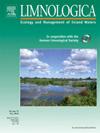海岸线发展指数的偏差:通过分析沿岸-深海生境耦合说明生态影响
IF 2
4区 环境科学与生态学
Q2 LIMNOLOGY
引用次数: 0
摘要
我们使用经过偏差校正的海岸线发展指数变体,重新研究了海岸线发展指数与生境耦合指标之间的关系。我们的研究结果表明,之前报道的相关性可能是海岸线发育指数测量中规模依赖性偏差的伪影。这些结果突出表明,在寻求了解湖泊形态与生态过程之间的联系时,需要进行仔细的测量。本文章由计算机程序翻译,如有差异,请以英文原文为准。
Bias in the shoreline development index: Ecological implications illustrated with an analysis of littoral-pelagic habitat coupling
We reexamined the relationship between the shoreline development index and metrics of habitat coupling using a bias-corrected variant of the shoreline development index. Our findings suggest that previously reported correlations may be artifacts of scale-dependent bias in shoreline development index measurements. The results highlight the need for careful measurement when seeking to understand links between lake morphology and ecological processes.
求助全文
通过发布文献求助,成功后即可免费获取论文全文。
去求助
来源期刊

Limnologica
环境科学-湖沼学
CiteScore
3.70
自引率
5.90%
发文量
64
审稿时长
3 months
期刊介绍:
Limnologica is a primary journal for limnologists, aquatic ecologists, freshwater biologists, restoration ecologists and ecotoxicologists working with freshwater habitats.
 求助内容:
求助内容: 应助结果提醒方式:
应助结果提醒方式:


